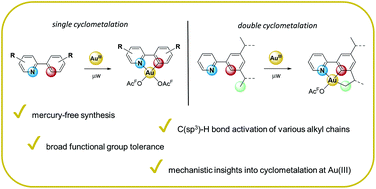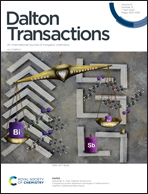Synthesis of substituted (N,C) and (N,C,C) Au(iii) complexes: the influence of sterics and electronics on cyclometalation reactions†
Abstract
Cyclometalated Au(III) complexes are of interest due to their catalytic, medicinal, and photophysical properties. Herein, we describe the synthesis of derivatives of the type (N,C)Au(OAcF)2 (OAcF = trifluoroacetate) and (N,C,C)AuOAcF by a cyclometalation route, where (N,C) and (N,C,C) are chelating 2-arylpyridine ligands. The scope of the synthesis is explored by substituting the 2-arylpyridine core with electron donor or acceptor substituents at one or both rings. Notably, a variety of functionalized Au(III) complexes can be obtained in one step from the corresponding ligand and Au(OAc)3, eliminating the need for organomercury intermediates, which is commonly reported for similar syntheses. The influence of substituents in the ligand backbone on the resulting complexes was assessed using DFT calculations, 15N NMR spectroscopy and single-crystal X-ray diffraction analysis. A correlation between the electronic properties of the (N,C) ligands and their ability to undergo cyclometalation was found from experimental studies combined with natural charge analysis, suggesting the cyclometalation at Au(III) to take place via an electrophilic aromatic substitution-type mechanism. The formation of Au(III) pincer complexes from tridentate (N,C,C) ligands was investigated by synthesis and DFT calculations, in order to assess the feasibility of C(sp3)–H bond activation as a synthetic pathway to (N,C,C) cyclometalated Au(III) complexes. It was found that C(sp3)–H bond activation is feasible for ligands containing different alkyl groups (isopropyl and ethyl), although the C–H activation is less energetically favored compared to a ligand containing tert-butyl groups.



 Please wait while we load your content...
Please wait while we load your content...